This was published 8 years ago
Copenhagen's hottest restaurants (where the bread tastes so damn good)
By Ute Junker
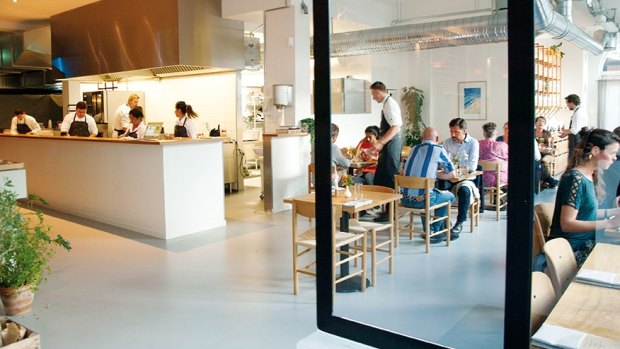
Dining in a brew pub.
Paleo fans, beware. Copenhagen's bread is going to get to you. The first thing that strikes you about Copenhagen's hottest restaurants – apart from the complimentary water, still or sparkling, that is automatically offered – is how damn good their bread is.
Take the bread at Restaurant Spontan. A dark and malty sourdough, it is made with a secret recipe that includes a dash of beer, a nod to the fact that Spontan is located inside the city's newest microbrewery. The sticky glaze that coats the crust is so good, it had me licking my fingers. (Sorry, mum.)
Bread this good bodes well for the meal to come, and Spontan doesn't disappoint. Chef Christian Gadient is one of Copenhagen's rising culinary stars. Earlier this year, he was awarded a Michelin star at the distinguished Marchal dining room in the D'Angleterre Hotel, making him the youngest Michelin star chef in town. He promptly quit to open his own restaurant – all at the ripe old age of 28. "I was doing breakfast, lunch, dinner and room service seven days a week, with 36 staff in the kitchen," Gadient says. "I was spending a lot of time on emails. Now I have more time to work on dishes, more time to myself. You can taste it in the food."
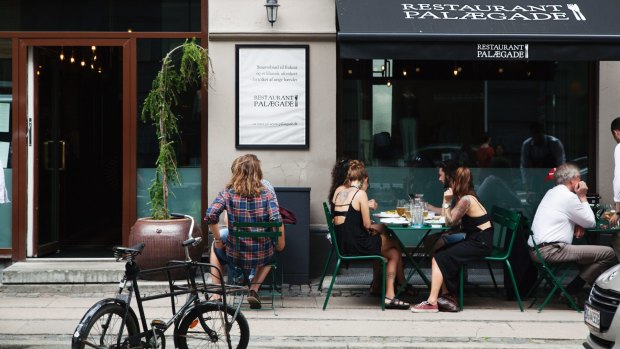
Restaurant Palaegade.
Certainly Gadient is doing something right. His four-course menu (you can upsize to five, six or seven courses) features dishes that are playful and unpredictable, without getting overly complicated. Peaches and Pearls, for instance, turns out to be a diced mix of white peach and squid, served with Baeri caviar and an intense blackcurrant jelly that is actually pure fruit, pureed at high speed to achieve a syrupy consistency. The flavours are bright and bold; interestingly, not a single ingredient in this power-packed dish has actually been cooked.
Gadient is one of a new generation of chefs reshaping Copenhagen's dining scene. Over the past decade, critically acclaimed restaurants such as Noma and Geranium – the so-called New Nordic wave – sent the Danish capital's culinary credibility skyrocketing. However, many ordinary diners found themselves put off by the idea of meals that go on forever (dinner at Geranium stretches past 20 courses); by the unusual ingredients (not everyone is interested in trying lichen); and, above all, the cost. Nothing in Denmark is cheap, but a 1900DKK meal – and that's without drinks – puts you in a different stratosphere.
Copenhagen's hot young chefs are doing it differently. "A lot of talented chefs are now doing restaurants that are affordable," says local restauranteur, Christian Lytje. Although many of these chefs trained at Noma, they are rethinking the strict rules that govern New Nordic cuisine. Gadient, for one, is happy to move beyond the New Nordic requirement that all ingredients be strictly local, adding the occasional exotic flavour such as finger lime.
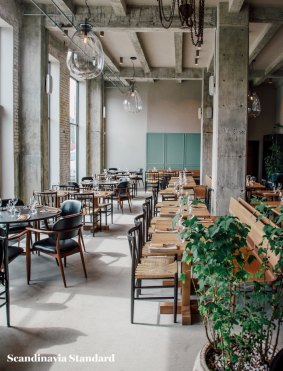
Noma.
"It's nice to get in some different ingredients," he says. "There are only so many new dishes you can do with an artichoke. Whether you make a entree or a dessert, it's still artichoke."
CHOOSE YOUR OWN ADVENTURE
Gadient is not the only one pushing the boundaries. As Noma prepares to close its doors at the end of the year, one of Redzepi's favourite proteges has opened a new restaurant just around the corner. Kristian Baumann's 108 is co-owned by Redzepi, but its lively, relaxed atmosphere is deliberately very different from the ambience at Noma.
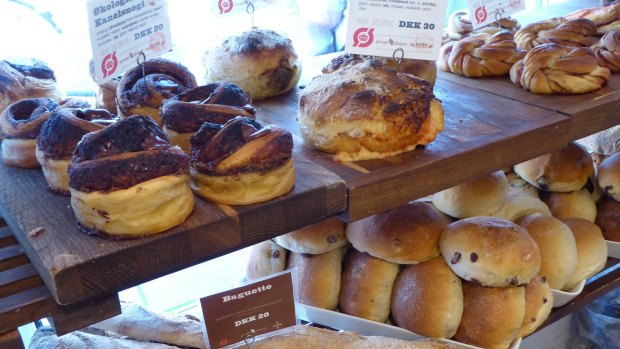
Pastries in Meyer bakery.
"I want people to choose their own night out," says Baumann. Ditching the degustation approach, Baumann's a la carte menu is divided into smaller and larger plates. "Three guys might come in here and spend 1000 kroner on food, or three guys might come in here and spend a few hundred kroner on food."
Like Gadient, Baumann plays with global flavours. One of his signature dishes is inspired by a banh xeo, or Vietnamese pancake, using caramelised milk skin as the pancake. Yet his basic principles remain true to his New Nordic training.
"There are five pillars in what we do," he says. They include foraging, fermenting, working closely with their producers, and the restaurant farm, which includes a test field. More than 190 different crops are trialled there, including three different types of shiso and 11 types of Jerusalem artichokes. Baumann goes to the farm every morning to collect the produce he will use that day.
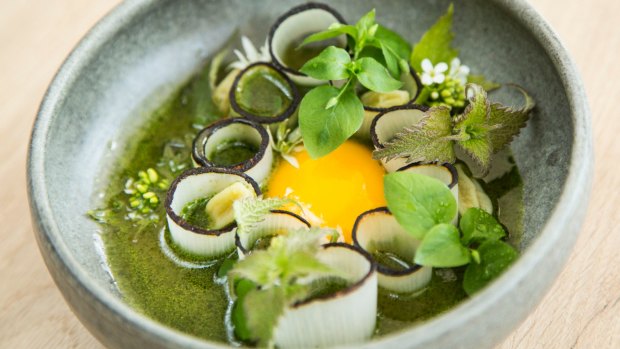
Spring on a plate at Spontan.
Unusually, 108 is open seven days a week: Baumann says he wanted to give restaurant staff somewhere that they could go on their days off. The food is as precise and surprising as you might expect of a Noma alumnus. An anodyne-sounding dish of "stems of romaine salad" turns out to be an umami-filled flavour bomb, drawing its punch from the addition of parsley oil, a paste made from the lettuce leaves, and aged turbot roe. Served beneath a blazing carpet of marigold petals, it looks almost better than it tastes.
Other Copenhagen chefs are exploring more familiar pastures. Until its recent surge to the top of the culinary pops, Denmark's greatest contribution to the food world was smorrebrod, open-topped sandwiches which feature in an estimated 600 variations. At one hot new restaurant, Palaegade, a lunch menu dedicated to smorrebrod is drawing the crowds.
"Smorrebrod is one of the only things that pulls us together," says co-owner Simon Olesen. "If you try to eat out at a family, everyone is likely to want something else. But smorrebrod is important to all of us."
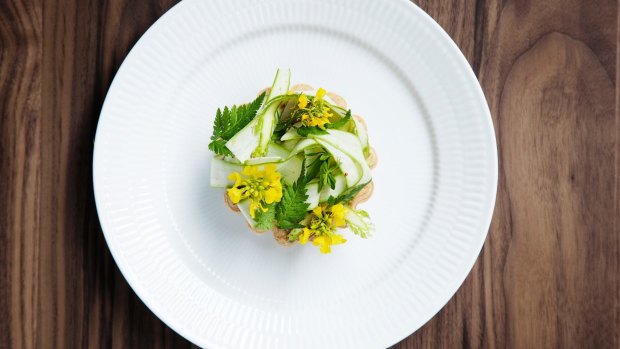
Palaegade's tart of veal, asparagus and morel.
Palaegade's evening menu also focuses on traditional Danish flavours, albeit with a more creative flair. My favourite is a spectacular plate of cod carpaccio served with mustard creme, capers, beetroots and a crispy egg. Olesen explains that is a take on a traditional Danish new year's dish, where cooked white cod is served with hardboiled eggs and mustard. "People recognise the flavours, but it's in a different form," Olesen says.
Drawing attention for a different reason is restaurant Vakst, with its striking greenhouse interior. The restaurant belongs to Christian Lytje's Cofoco group, which specialises in eateries that are smart, stylish and affordable. As Lytje points out, small restaurants are by definition more expensive. "We focus on bigger places. We still spend money on interiors, we still offer diners an experience, but we can do so at a good price."
Certainly Vakst, the newest of the group's 14 restaurants, offers unbeatable prices, just 295 kroner for a three-course lunch. My entree of ashed hake is followed by a plate of perfect grilled chicken. Quality food at good prices: now that's a change for the better.
TRIP NOTES
MORE INFORMATION
visitcopenhagen.com/copenhagen-tourist.
GETTING THERE
Finnair flies to Copenhagen via Helsinki. See finnair.com/au/gb/.
STAYING THERE
The apartment-style Adina Copenhagen offers stylish accommodation about 10 minutes away from downtown Copenhagen. Rates from $304. See tfehotels.com/brands/adina-apartment-hotels/adina-apartment-hotel-copenhagen.
EATING THERE
Restaurant Spontan: A Michelin-starred chef loses the fripperies and focuses on the food in this brewpub. Guldbergsgade 29F, tapperietbrus.dk/spontan.
108: This sister restaurant to Noma shares the same refined culinary sensibility, but offers a more buzzy – and affordable – night out. Strandgade 108, 108.dk/en.
Palaegade: Locals flock here at lunchtime for traditional smorrebrod, but we recommend coming at night for the reinvented Danish classics. Palaegade 8, palaegade.dk/frontpage.
Vakst: With an interior styled like a greenhouse, this stylish new eatery offers the best value lunches in town. Sankt Peders Stræde 34, hostvakst.dk/vakst/?lang=en.
Ute Junker travelled courtesy of Vola and Adina Hotels.
COPENHAGEN CULINARY ESSENTIALS
Don't leave town without getting a mouthful of these experiences.
PLAY THE MARKET
The sleek Torvehallerne is Copenhagen's best food market, selling everything from fresh-from-the-oven cinnamon buns to Danish cheeses. With more than 60 stalls, it's a gourmet wonderland.
COFFEE CULTURE
Ask any local, and they will tell you the best coffee in town comes from the Coffee Collective. They supply beans to many local cafes but have their outlets of their own, including the ever-busy outlet on Jaegersborggade. See coffeecollective.dk.
OLD-SCHOOL DANISH
To get a taste of traditional Danish dining, head for Schonnemann's, in business since 1877. The restaurant, which showcases local favourites such as smorrebrod, pickled herring and schnapps, is open only at lunchtime. See restaurantschonnemann.dk/?ulang=2.
MEATPACKING DISTRICT
This cluster of bustling eateries includes something for every taste, from the Warpigs brewpub to the super-fresh seafood at Fiskebaren and – for something completely different – tacos at Hija de Sanchez. See warpigs.dk, fiskebaren.dk/en/fiskebaren, hijadesanchez.dk.
BLITZ BREAKFAST
Only the Danes could create an empire of cool eateries based around porridge. The seasonal menu at the hip Gred cafe – four outlets and counting – includes dishes such as spelt porridge with chestnut puree, apple and toasted almonds. See groed.com/en.
Sign up for the Traveller Deals newsletter
Get exclusive travel deals delivered straight to your inbox. Sign up now.